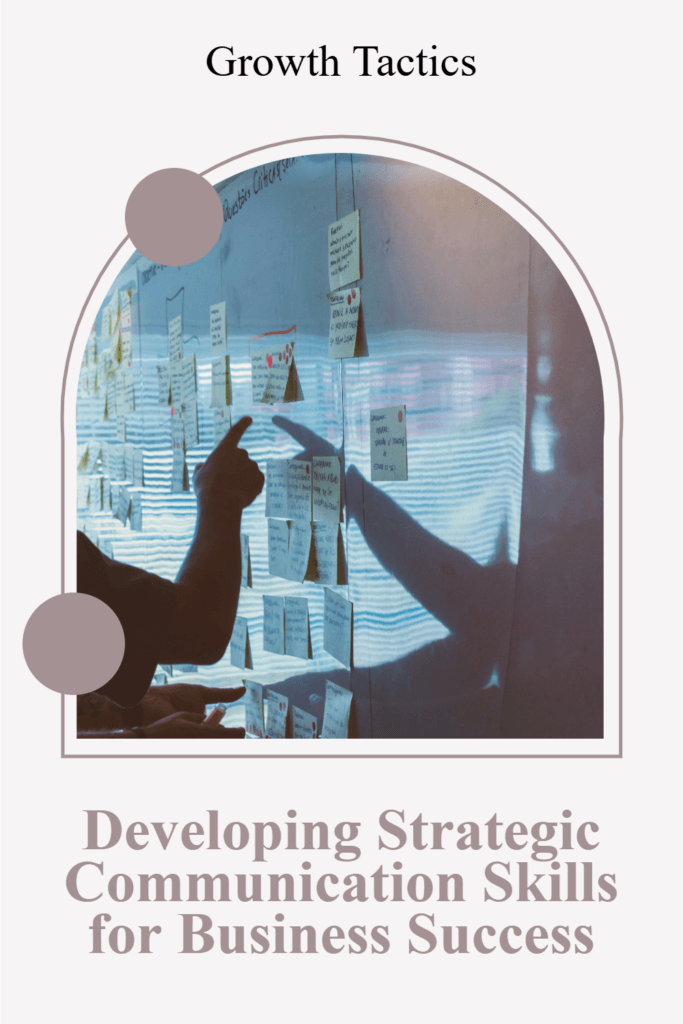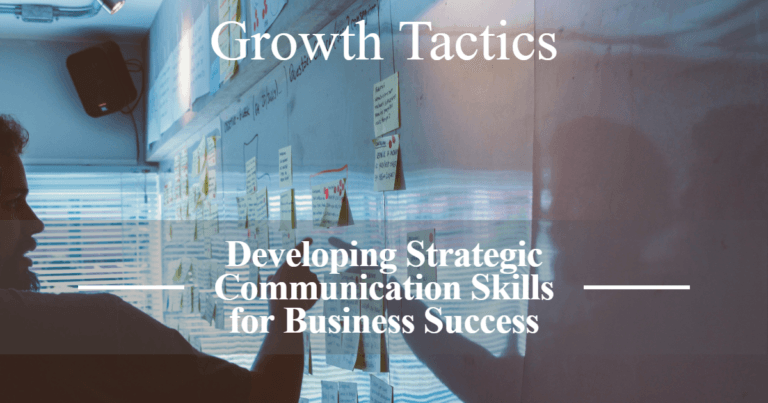Have you ever felt like your words just aren’t hitting the mark at work? I know I have. I’ve had times where I struggled to get my ideas across in meetings and emails. It was frustrating, to say the least. But then I discovered the power of strategic communication, and it changed everything. In this article, we’re going to talk about developing strategic communication skills.
These aren’t just fancy words, they’re real tools that can help you become a better leader, solve problems more effectively, and grow in your career. So, let’s explore how you can become a communication champion.
Jump To Section
What is the Purpose of Strategic Communication?
Let’s talk about why strategic communication matters. I’ve seen firsthand how it can make or break a business. It’s not just about talking; it’s about talking with a purpose.
Understanding the Key Messages in Strategic Communication
Key messages are the heart of your communication. They’re the big ideas you want people to remember. I once worked with a team that struggled to get their point across. We sat down and hammered out their key messages. Suddenly, everything clicked. People started listening.
Think about what you really want to say. What’s the most important thing? That’s your key message. Keep it simple and clear. Remember, it’s probably too complicated if you can’t explain it to a 10-year-old.
How to Define Your Communication Objectives
Setting objectives is like creating a roadmap for your communication. Without them, you’re just wandering around. I learned this the hard way in my early career. Now, I always ask myself: What do I want to achieve with this message?
Your objectives could be to inform, persuade, or inspire action. Whatever they are, write them down. Make them specific. For example, “I want to increase customer sign-ups by 20% this quarter.” This gives you something concrete to aim for.
The Importance of Stakeholder Engagement
Stakeholders are the people who care about what you’re doing. They could be customers, employees, or investors. Engaging them is crucial. I once saw a project fail because the team forgot to involve key stakeholders. Don’t make that mistake.
Talk to your stakeholders. Listen to their concerns. Include them in your planning. When people feel heard, they’re more likely to support you. It’s that simple.
How to Develop Effective Communication Strategies?
Now that we know the purpose, let’s talk about how to make it happen. Developing strategies isn’t as hard as it sounds. It’s about knowing who you’re talking to and how to reach them.
Identifying Your Target Audience
Who are you trying to reach? This is the first question you should ask. I’ve seen too many messages fall flat because they were aimed at the wrong people.
Think about who needs to hear your message. What do they care about? What problems do they have? Once you know this, you can tailor your message to fit their needs.
Different Types of Communication for Business
There’s no one-size-fits-all in communication. Sometimes you need a formal report. Other times, a quick chat works best. I’ve used everything from company-wide emails to one-on-one meetings.
The key is to match the type of communication to your audience and message. Don’t be afraid to mix it up. Try different approaches and see what works best for you and your team.
Utilizing the Right Mode of Communication
Should you send an email or make a phone call? Host a meeting or create a video? The mode you choose can make a big difference. I once turned a boring quarterly report into an engaging infographic. I feel like engagement and understanding soared.
Think about how your audience prefers to receive information. Consider the urgency and complexity of your message. Then choose the mode that fits best. Remember, the right mode can make your message stick.
What Are the Key Elements of a Successful Message?
Let’s talk about what makes a message stick. I’ve sent my fair share of emails that fell flat and learned a lot along the way. A successful message isn’t just about what you say, but how you say it.
Crafting Concise and Impactful Messages
Keep it short and sweet, folks. I focus on getting to the point quickly. Think about what you really need to say. Cut out the fluff.
Remember, people are busy. They don’t have time to listen to or read a novel. So, make every word count. Use strong verbs. Be specific. And always ask yourself, “Does this add value?” If not, cut it out.
How to Ensure Clear Communications
Clarity is king in communication. I once sent out a project brief that was so confusing, that my team didn’t know where to start. Now, I always ask myself, “Would a 10-year-old understand this?”
Use simple words. Short sentences. Break up big ideas into smaller chunks. And don’t be afraid to use examples or stories to explain complex ideas. The clearer you are, the more likely people are to understand and act on your message.
How to Know Your Audience for Better Communication Skills?
Knowing your audience is like having a secret weapon. It helps you hit the bullseye every time. But how do you get to know them? Let me share some tricks I’ve learned.
Researching Your Target Audience
Don’t guess what your audience wants, find out! I used to think I knew my audience, but when I actually started researching, I was surprised. There are so many ways to learn about your audience. Look at the data. Read comments. Talk to people.
Ask yourself: Who are they? What do they care about? What problems do they have? The more you know, the better you can communicate with them. It’s like learning their language.
Asking for Feedback to Improve Your Communication Efforts
Feedback is a gift. It might not always feel that way, but trust me, it is. I used to be scared of asking for feedback. Now, I can’t get enough of it. It’s the fastest way to improve.
Don’t be shy. Ask people what they think. Did your message make sense? Was it helpful? What could you do better? Listen to what they say. And remember, it’s not personal. It’s about getting better.
Identifying Areas for Improvement
We all have room to grow. I know I do! The trick is to figure out where. Maybe you struggle with being concise. Or perhaps your messages lack impact. Whatever it is, own it.
Look at your past communications. What worked? What didn’t? Be honest with yourself. And remember, improving is a journey. Take it one step at a time.
What Are the Best Practices for Crisis Communication?
Let’s face it, crises happen. I’ve been through a few myself, and I’ve learned that how you communicate can make or break the situation. It’s all about being prepared and staying calm.
Developing a Strategic Communication Plan
Having a plan is like having a life jacket, you hope you never need it, but you’re glad it’s there when you do.
Start by identifying potential crises. Who needs to know what? When? How? Write it all down. Practice it. Make sure everyone knows their role. Trust me, when things get tough, you’ll be glad you did this.
Managing External Communication During a Crisis
When a crisis hits, everyone’s watching. I’ve learned that honesty and clarity are your best friends.
Be upfront about what’s happening. Don’t hide facts. If you don’t know something, say so. Promise to find out and follow through. People can forgive mistakes, but they won’t forget lies.
Key Strategies for Effective Crisis Communication
Here’s what I’ve found works best:
- Be quick: Get ahead of the story.
- Be clear: Use simple language.
- Also, be consistent: Make sure everyone’s saying the same thing.
- Show empathy: Let people know you care.
- Take action: Show what you’re doing to fix things.
Remember, your goal is to build trust. Every word and every action should work towards that.
How to Assess Your Communication Skills?
Knowing where you stand is the first step to getting better. I used to think I was a great communicator until I really looked at my skills. Here’s how you can do the same.
Identifying Your Strengths in Communication
We all have our areas of strength. Maybe you’re great at explaining complex ideas. Or perhaps you’re a pro at reading body language. Whatever it is, find it and use it.
Think about times when your communication worked well. What did you do? Why did it work? These are clues to your strengths.
How to Tailor Your Communication Style
One size doesn’t fit all in communication. I learned this when I tried to use the same approach with my team and my boss. Big mistake!
Think about who you’re talking to. What do they need? What’s their style? Then adjust yours to match. It’s like speaking their language. When you do this, people listen more and understand better.
Setting Goals for Strategic Planning in Communication
Without a target, you’re just throwing darts in the dark. I set communication goals for myself every quarter. It keeps me focused and helps me improve.
Start small. Maybe you want to be more concise in emails. Or perhaps you want to get better at public speaking. Whatever it is, write it down. Make a plan to achieve it. And don’t forget to celebrate when you do!
Remember, great communication is a journey, not a destination. Keep working at it, and you’ll keep getting better.
Conclusion
Remember, developing strategic communication skills isn’t about becoming someone you’re not. It’s about finding your voice and using it effectively. I’ve seen firsthand how these skills can transform careers and businesses.


